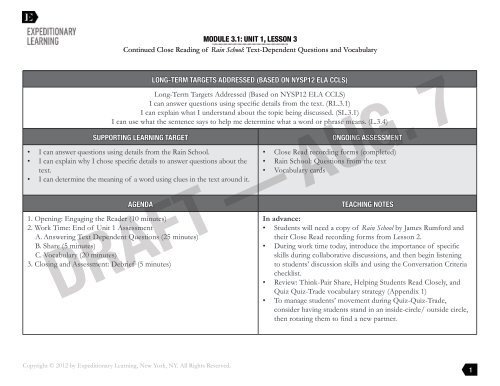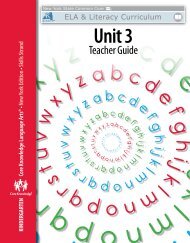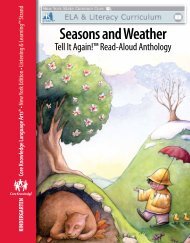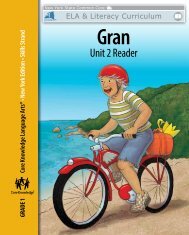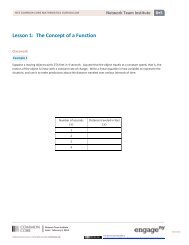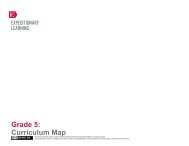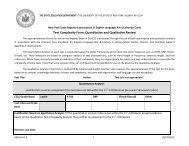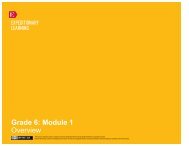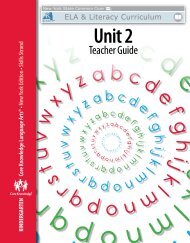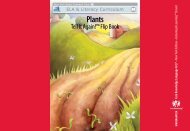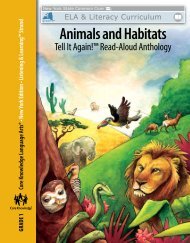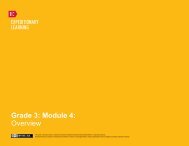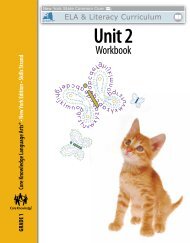Grade 3 ELA Module 1, Unit 1, Lesson - EngageNY
Grade 3 ELA Module 1, Unit 1, Lesson - EngageNY
Grade 3 ELA Module 1, Unit 1, Lesson - EngageNY
You also want an ePaper? Increase the reach of your titles
YUMPU automatically turns print PDFs into web optimized ePapers that Google loves.
Copyright © 2012 by Expeditionary Learning, New York, NY. All Rights Reserved.<br />
LONG-TERM TARGETS ADDRESSED (BASED ON NYSP12 <strong>ELA</strong> CCLS)<br />
Long-Term Targets Addressed (Based on NYSP12 <strong>ELA</strong> CCLS)<br />
I can answer questions using specific details from the text. (RL.3.1)<br />
I can explain what I understand about the topic being discussed. (SL.3.1)<br />
I can use what the sentence says to help me determine what a word or phrase means. (L.3.4)<br />
SUPPORTING LEARNING TARGET ONGOING ASSESSMENT<br />
• I can answer questions using details from the Rain School.<br />
• I can explain why I chose specific details to answer questions about the<br />
text.<br />
• I can determine the meaning of a word using clues in the text around it.<br />
1. Opening: Engaging the Reader (10 minutes)<br />
2. Work Time: End of <strong>Unit</strong> 1 Assessment<br />
A. Answering Text Dependent Questions (25 minutes)<br />
B. Share (5 minutes)<br />
C. Vocabulary (20 minutes)<br />
3. Closing and Assessment: Debrief (5 minutes)<br />
MODULE 3.1: UNIT 1, LESSON 3<br />
Continued Close Reading of Rain School: Text-Dependent Questions and Vocabulary<br />
• Close Read recording forms (completed)<br />
• Rain School: Questions from the text<br />
• Vocabulary cards<br />
AGENDA TEACHING NOTES<br />
In advance:<br />
• Students will need a copy of Rain School by James Rumford and<br />
their Close Read recording forms from <strong>Lesson</strong> 2.<br />
• During work time today, introduce the importance of specific<br />
skills during collaborative discussions, and then begin listening<br />
to students’ discussion skills and using the Conversation Criteria<br />
checklist.<br />
• Review: Think-Pair Share, Helping Students Read Closely, and<br />
Quiz Quiz-Trade vocabulary strategy (Appendix 1)<br />
• To manage students’ movement during Quiz-Quiz-Trade,<br />
consider having students stand in an inside-circle/ outside circle,<br />
then rotating them to find a new partner.<br />
DRAFT — AUG. 7<br />
1
VOCABULARY MATERIALS<br />
<strong>Lesson</strong> Vocabulary:<br />
evidence, detail, question, clue, sapling, knowledge, rumpled,<br />
slump<br />
MODULE 3.1: UNIT 1, LESSON 3<br />
Continued Close Reading of Rain School: Text-Dependent Questions and Vocabulary<br />
Copyright © 2012 by Expeditionary Learning, New York, NY. All Rights Reserved.<br />
• Anchor chart: Close Read recording form for Rain School (from <strong>Lesson</strong> 2)<br />
• Rain School (one per student)<br />
• Sticky notes<br />
• Chart: A question from the text<br />
• Rain School text dependent questions<br />
• 8.5” x 11” sheet of white paper<br />
• 3” x 5” index cards (one for each student)<br />
• Anchor chart: Close Readers Do These Things (begun in <strong>Lesson</strong> 2)<br />
LESSON PLAN<br />
OPENING MEETING STUDENTS’ NEEDS<br />
A. Engaging the Reader (10 minutes)<br />
• Gather students in a circle. Direct their attention to the anchor chart: Close Read recording form for Rain<br />
School from the previous lesson.<br />
• Remind students about the simple Think-Pair-Share process they practiced yesterday: they get time to first think<br />
on their own and then talk with a partner. Then as a group, some students will share their own thinking or<br />
something smart their partner said or asked.<br />
• Ask: “What were some important details in the story Rain School we read yesterday?” Have students Think-Pair-<br />
Share.<br />
• Repeat the Think-Pair-Share with a second question: “What did we do as readers to help us understand this<br />
story better?”<br />
• After students have shared, transition, focusing students on the learning targets for this lesson. Invite a student<br />
to read aloud the learning target: “I can answer questions using details from Rain School.” Ask students to think<br />
about that learning target. Circle the word questions and the phrase details from the text. Discuss as a group how<br />
these two parts of the learning target might be connected.<br />
Asking students to talk<br />
about details from the day<br />
before helps build academic<br />
vocabulary for all students.<br />
DRAFT — AUG. 7<br />
2
MODULE 3.1: UNIT 1, LESSON 3<br />
Continued Close Reading of Rain School: Text-Dependent Questions and Vocabulary<br />
Copyright © 2012 by Expeditionary Learning, New York, NY. All Rights Reserved.<br />
WORK TIME MEETING STUDENTS’ NEEDS<br />
A. Answering Text Dependent Questions (25 minutes)<br />
• Distribute Rain School to students. Remind students that they have already heard or read Rain School<br />
three times (in <strong>Lesson</strong> 2): the read aloud for enjoyment and to get the flow of the story, once on their<br />
own and with groups to get the gist of it and find unfamiliar vocabulary, and then with groups to find<br />
and record important details and think about the story’s message or lesson.<br />
• Tell students that today they are going to be reading the story Rain School on their own and in groups<br />
again. This time, they will answer questions whose answers can only be found inside the text.<br />
• Distribute the students’ copies of Rain School.<br />
• Tell students this process happens in two parts. The first part is finding the evidence in the text that will<br />
help answer the question. Discuss the word evidence: “Evidence is something we use to prove an idea we<br />
have. Remind them that yesterday they practiced being reading detectives, and that detectives look for<br />
evidence: clues, details to help them figure something out.<br />
• Display the Chart: A question from the text. “How will school be different for Thomas when he starts<br />
again in September?” Tell students you will read the whole text, keeping this question in mind, and when<br />
you find evidence, you will underline it. Model this process. This can be done by silently reading Rain<br />
School in front of the class. Consider exaggerating the reading, scanning with eyes and a finger, whispering<br />
some parts aloud, etc. Invite students to read along silently on their own copies. Consider telling students<br />
to give a silent signal, like thumb-up, if they think they found evidence to answer the question.<br />
• Read aloud the section: “Come September, school will start over. Thomas will be a big brother<br />
then, leading the children on their first day of school.” Think aloud: “Aha! This part is talking about<br />
September, which is in the question. Does it say how things will be different? Well, it says that he will be<br />
a big brother then, which will be different for him, because in the story he was the little brother. So I am<br />
going to jot down this evidence.” Model writing a paraphrased version of the evidence on a sticky note.<br />
Tell students that they will now try this with a few questions on their own.<br />
• Distribute Rain School: Questions from the Text and sticky notes and allow students to begin working<br />
independently. As students begin to work, remind them that they should read the questions first, and<br />
then jot evidence when they think they have found answers. They are not actually writing answers yet.<br />
Circulate and assist students as needed.<br />
• After students have worked for about 10 minutes, pause them and ask them to discuss as a group the<br />
evidence they found for each question.<br />
• For ELLs and students needing<br />
additional supports, consider<br />
providing smaller chunks of<br />
text, or having them focus on<br />
fewer text dependent questions.<br />
If necessary, consider chunking<br />
the text for them, pointing<br />
them to pages where some of<br />
the answers can be found.<br />
• Consider partnering an ELL<br />
with a student who speaks the<br />
same L1, when discussion of<br />
complex content is required.<br />
This can allow students to have<br />
more meaningful discussions<br />
and clarify points in their L1.<br />
• When ELLs are asked to<br />
produce language, consider<br />
providing a sentence frame<br />
or sentence starter to assist<br />
with language production.<br />
For example: “The text says<br />
___________,” “I read<br />
that_________,” or “I found<br />
evidence here that _________.”<br />
DRAFT — AUG. 7<br />
3
MODULE 3.1: UNIT 1, LESSON 3<br />
Continued Close Reading of Rain School: Text-Dependent Questions and Vocabulary<br />
Copyright © 2012 by Expeditionary Learning, New York, NY. All Rights Reserved.<br />
WORK TIME MEETING STUDENTS’ NEEDS<br />
• Remind students that they will be thinking and talking a lot together this year. Tell them that today you<br />
will be listening in to see how they are doing with their discussion skills. In the interest of time, consider<br />
assigning each group one specific question to discuss.<br />
• Tell students that they will now be using this evidence to write an answer to the questions. Model this<br />
process for them by thinking aloud the answer while writing it on the chart. This may sound like: “The<br />
question says ‘How will school be different for Thomas when he starts again in September?’ Well, I’m<br />
going to use the words in the question to begin my answer, so I will write ‘School will be different for<br />
Thomas because . . .’ ” Refer back to the evidence in the text, “Oh yeah, the text says, ‘Thomas will be a<br />
big brother, leading the other children.’ So I can finish my sentence with: ‘he will now big a big brother<br />
instead of a little brother, and he will lead the other children.’ ”<br />
• Direct students back to their Rain School: Questions from the Text, inviting them to try writing answers.<br />
Remind them that the first part of the answer came from words in the question, while the second part of<br />
the answer came from the evidence in the text. Circulate and support students as they write.<br />
B. Share (5 minutes)<br />
• After students have written for 10 minutes, ask them to pause and share their answers with their group.<br />
They can do this one question at a time; or, again, consider assigning each group a question to discuss,<br />
probably an early question in case they did not get to the latter ones. Tell students they will be able to<br />
finish their answers tonight for homework.<br />
• Briefly add to the Close Readers Do These Things anchor chart (begun in <strong>Lesson</strong> 2). Students will<br />
continue to add to this chart on each subsequence cycle of close reading a text.<br />
DRAFT — AUG. 7<br />
4
MODULE 3.1: UNIT 1, LESSON 3<br />
Continued Close Reading of Rain School: Text-Dependent Questions and Vocabulary<br />
Copyright © 2012 by Expeditionary Learning, New York, NY. All Rights Reserved.<br />
WORK TIME MEETING STUDENTS’ NEEDS<br />
C. Vocabulary (20 minutes)<br />
• Students will now work with the words they listed during their second reading of Rain School. Gather students<br />
in a circle, and tell them that they will now be learning a strategy for when they come across an unknown or<br />
difficult word while reading. Read the learning target, “I can determine the meaning of new vocabulary using<br />
clues in the text around a word.” Ask students if this learning target gives them any ideas of what they will be<br />
doing with unknown words. Share ideas as a whole class. (Listen for comments like “I will try to figure it out<br />
from other stuff on the page.”)<br />
• Return to the projected copy of Rain School used in <strong>Lesson</strong> 2. Remind students about how you had written<br />
down the word sapling because the word was unfamiliar. Tell them that you will now go back to that word and<br />
try to figure it out its meaning. Tell students that one way to figure out the meaning of a word is to look at<br />
other words in the sentence and think about clues the sentence gives you, and then try to replace the word<br />
with a word they know.<br />
• On one side of an 8.5” x 11” sheet of white paper, write the sentence: “He gathers grass and saplings with<br />
the other children, and they make a roof.” Circle the word sapling. Think aloud the process of using clues in<br />
the sentence. “So, Thomas gathers the sapling, so it must be a noun, because it’s a thing he can pick up. Also,<br />
he picks it up with the grass, so I’m guessing it might also be a plant. They use it to make a roof, and I’ve seen<br />
roofs in pictures made of grass and branches from trees. So I’m thinking that sapling must mean something like<br />
branch or small tree.” On the back of the 8.5” x 11” sheet of white paper write branch or small tree.<br />
• Distribute a 3” x 5” index card to each student. Tell them that they will now choose a word from the<br />
unfamiliar words they wrote to repeat this same process. Give students 5 minutes of independent work time<br />
to do this with one word. Remind them that on one side they write the whole sentence that the word is in,<br />
circling the unknown word. On the other side, they are to write two possible words that it might be similar to.<br />
• Gather students back in the circle. Tell them they are going to play a quick game called Quiz-Quiz-Trade. In<br />
this game they will partner up with another student. When the teacher says “quiz,” one student will show their<br />
DRAFT — AUG. 7<br />
sentence with a word circled. Their partner will then try and guess one of the two words on the reverse side<br />
of the card. When the teacher says “quiz” again, the other student will show their sentence. Finally, the teacher<br />
will say “trade” and students must trade partners with someone near them. Consider modeling this with one<br />
student. Allow students to play Quiz-Quiz-Trade for 5 minutes.<br />
5
MODULE 3.1: UNIT 1, LESSON 3<br />
Continued Close Reading of Rain School: Text-Dependent Questions and Vocabulary<br />
Copyright © 2012 by Expeditionary Learning, New York, NY. All Rights Reserved.<br />
CLOSING AND ASSESSMENT MEETING STUDENTS’ NEEDS<br />
A. Debrief (5 minutes)<br />
• Debrief, in a whole group, with the question, “How could the new word that you learned help you better<br />
understand the text?”<br />
HOMEWORK MEETING STUDENTS’ NEEDS<br />
• Tonight you need to complete any of the questions you may not have finished on the Rain School<br />
Questions from the Text sheet. Remember to use details from the text to support your answers. To do this<br />
you will need your copy of Rain School.<br />
• Teacher Note<br />
• In <strong>Lesson</strong>s 4, 5, 6, and 7 students will engage in various group discussions. During these conversations,<br />
teacher will be collecting data for the mid-unit assessment using the Conversation Criteria checklist.<br />
For ELLs or struggling<br />
readers, consider highlighting<br />
their text to help them find<br />
some important details that<br />
will help them answer the<br />
questions.<br />
DRAFT — AUG. 7<br />
6
Name:<br />
Date:<br />
Copyright © 2012 by Expeditionary Learning, New York, NY. All Rights Reserved.<br />
Supporting Materials: Rain School: Questions from the Text<br />
1. According to the text, what is the first lesson the teacher says the students will learn?<br />
2. How does the author describe the inside of the school?<br />
MODULE 3.1: UNIT 1, LESSON 3<br />
3. How does the teacher in this story feel about her students’ work? Use details from the story.<br />
7
4. Why does the author say “it doesn’t matter” that the school has disappeared? Use details to support your answer.<br />
5. Read this sentence from the story: “Their notebooks are rumpled from learning.” Based on the text, the word rumpled means:<br />
a. new<br />
b. full<br />
c. worn<br />
d. heavy<br />
Copyright © 2012 by Expeditionary Learning, New York, NY. All Rights Reserved.<br />
MODULE 3.1: UNIT 1, LESSON 3<br />
Supporting Materials: Rain School: Questions from the Text<br />
8


